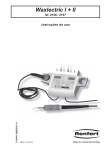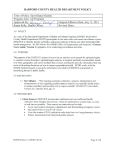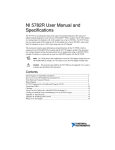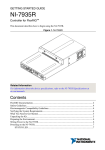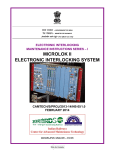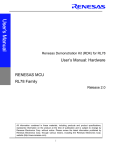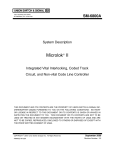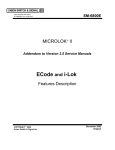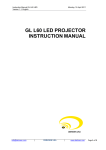Download Microlok Computer Based Interlocking - ARTC - Intranet
Transcript
Discipline Engineering Standard –NSW Category Signalling Title Microlok Computer Based Interlocking Reference Number SMP 38 –(RIC Standard: SC 00 52 00 38 SI) Document Control Status Issue 1 Revision 2 Date Prepared Reviewed Endorsed Approved Standards and Systems Standards Engineer GM Infrastructure Strategy & Performance Safety Committee Refer to Reference Number H Olsen M Owens Refer to minutes of meeting 12/08/04 Mar 05 Engineering Standard –NSW Signalling Microlok Computer Based Interlocking SMP 38 Disclaimer Australian Rail Track Corporation has used its best endeavors to ensure that the content, layout and text of this document is accurate, complete and suitable for its stated purpose. It makes no warranties, express or implied, that compliance with the contents of this document shall be sufficient to ensure safe systems of work or operation. Australian Rail Track Corporation will not be liable to pay compensation in respect of the content or subsequent use of this document for any other purpose than its stated purpose or for any purpose other than that for which it was prepared except where it can be shown to have acted in bad faith or there has been willful default. Document Approval The technical content of this document has been approved by the relevant ARTC engineering authority and has also been endorsed by the ARTC Safety Committee. Document Supply and Control The Primary Version of this document is the electronic version that is available and accessible on the Australian Rail Track Corporation Internet and Intranet website. I ti st hedocumentuser ’ ssole responsibility to ensure that copies are checked for currency against the Primary Version prior to its use. Copyright The information in this document is Copyright protected. Apart from the reproduction without alteration of this document for personal use, non-profit purposes or for any fair dealing as permitted under the Copyright Act 1968, no part of this document may be reproduced, altered, stored or transmitted by any person without the prior written consent of ARTC. March 2005 Version 1.2 © Australian Rail Track Corporation This document is uncontrolled when printed. Page 2 of 22 Engineering Standard –NSW Signalling Microlok Computer Based Interlocking SMP 38 About This Standard The first part of this document applies to Microlok Plus cardfiles, which are generally known within ARTC as the earlier Microlok 1 interlockings. It is basically the same as previously issue 1.0 of this maintenance document. The second part of this document applies to the Microlok II interlockings (including the Microtrax coded track cards). As these Union Switch & Signal products are always being enhanced and developed it is important to make sure that you have the latest version of the manufacturers manuals. Many Microlok II installations also have site specific Signalling Maintenance Instructions which must be referenced before conducting maintenance on this equipment. March 2005 Version 1.2 © Australian Rail Track Corporation This document is uncontrolled when printed. Page 3 of 22 Engineering Standard –NSW Signalling Microlok Computer Based Interlocking SMP 38 Document History Primary Source –RIC Standard SC 00 52 00 38 SI Version 2.1 List of Amendments – ISSUE DATE 1.1 1.2 01/09/2004 14/03/2005 March 2005 Version 1.2 CLAUSE Disclaimer DESCRIPTION Reformatting to ARTC Standard Minor editorial change © Australian Rail Track Corporation This document is uncontrolled when printed. Page 4 of 22 Engineering Standard –NSW Signalling Microlok Computer Based Interlocking SMP 38 Contents 1 MICROLOK AND MICROLOK PLUS ................................................................................7 1.1 SCOPE .........................................................................................................................7 1.2 REFERENCES ...................................................................................................................7 1.3 REPAIR ........................................................................................................................7 1.4 MAINTENANCE ...............................................................................................................8 1.4.1 90 day Maintenance .............................................................................................8 1.4.2 Removal of Boards ...............................................................................................8 1.4.3 Insulation Testing .................................................................................................8 1.5 ANALYSIS OF ERROR CODES ......................................................................................8 1.6 SYSTEM FAILURE AND INITIALISATION .................................................................9 1.6.1 Blocking ................................................................................................................9 1. 6.2 Point Detection & Controls ..................................................................................9 1. 6.3 Removal and Replacement of Boards .................................................................10 1. 6.4 Failure of Peripheral Board ...............................................................................10 1. 6. 5 Failure of EPROMs ............................................................................................10 1. 6. 6 Failure Log .........................................................................................................11 1.7 STORAGE AND TESTING OF BOARDS .....................................................................11 1. 8 PROTECTION OF THE LINE ........................................................................................................................ 11 1.8.1 Disconnections ...................................................................................................11 1.8.2 CBI Workstation .................................................................................................12 1.8.3 Blocking Pins ......................................................................................................12 1.8.4 Relay interface ....................................................................................................12 1.8. 5 Lamp Driver Outputs ..........................................................................................13 1.9 TRACK SEQUENCING ..................................................................................................13 1.10 GENISYS .......................................................................................................................14 2 MICROLOK II .......................................................................................................................15 2.1 SCOPE ...............................................................................................................................................................1 5 2.2 REFERENCES ..................................................................................................................................................1 5 2.3 REPAIR .............................................................................................................................................................1 5 2.4 MICROLOK II SPECIFIC ISSUES ..............................................................................................................1 5 2. 5 ELSAFE MODULES ................................................................................................................................................ 16 2. 6 MAINTENANCE ....................................................................................................................................................... 16 2.7 INSULATION TESTING ................................................................................................................................. 17 2. 8 ANALYSIS OF ERROR CODES ........................................................................................................................... 18 2.9 SYSTEM FAILURE AND INITIALISATION .............................................................................................. 18 2.9.1 Initialisation .......................................................................................................18 2.9.2 CPS Shutdown ....................................................................................................18 2.9.3 Failure of CPU Module ......................................................................................18 2.10 REPLACEMENT OF MODULES ......................................................................................................................... 19 2.11 FAILURE REPORTING .......................................................................................................................................... 19 2.12 PROTECTION OF THE LINE ................................................................................................................................ 20 2.12.1 Disconnections .........................................................................................................20 2.12.2 CBI Workstation ......................................................................................................20 2.12.3 Blocking Pins ...........................................................................................................20 2.12.4 Relay interface .........................................................................................................21 2.12. 5 Lamp Driver Outputs ..............................................................................................21 2.12.6 Microtrax Coded Track Circuit ...............................................................................22 March 2005 Version 1.2 © Australian Rail Track Corporation This document is uncontrolled when printed. Page 5 of 22 Engineering Standard –NSW Signalling Microlok Computer Based Interlocking SMP 38 2.13 S ECURITY OF M ICROLOK II S OFTWARE.................................................................................................... 22 March 2005 Version 1.2 © Australian Rail Track Corporation This document is uncontrolled when printed. Page 6 of 22 Engineering Standard –NSW Signalling Microlok Computer Based Interlocking SMP 38 1 MICROLOK and MICROLOK plus 1.1 SCOPE The following instructions relate to computer based interlocking equipment. A Microlok and Microlok Plus card file can be considered as having the equivalent function as a rack of relays, with the logic programmed in Boolean. TheMi c r ol ok’ scan be configured in various ways from a single card file interfacing to standard relay circuits, to a series of distributed card files connected via vital serial links, and direct lamp driver cards. Workstations may be provided to give diagnostic logging and for the application and removal of maintenance blocks. ARTC’ sa p pl i c a t i onus e st heMi c r ol okPl usc onf i gur a t i on,whi c hi nc l ude saGe ni s y ss y s t e m as part of the Microlok card file. Genisys provides the interface to the code server and can be considered as equivalent to a non-vital relay panel and telemetry system. This configuration is referred to as a Microlok 1 interlocking. It is currently no longer installed on new works as the Microlok 1 has been superseded with the newer Microlok II product. 1.2 REFERENCES The Microlok and Genisys systems are detailed in the following Union Switch and Signal publications: Genisys Non-Vital Application Logic Programming Service Manual 6300A Installation and Field Maintenance Service Manual 6300B Shop Maintenance Service Manual 6300C Microlok & Microlok Plus Vital Application Logic Programming Service Manual 6400A Hardware Installation, Power & Data Interfacing Service Manual 6400B Field Maintenance Service Manual 6400C Generally this document relates to the Microlok Field Maintenance Manual 6400C. Where there is a conflict between this document and Manual 6400C, this document is to take precedence. 1.3 REPAIR Field repairs are not to be carried out on any vital Microlok cards or CPU power supply. These items must be returned to the manufacturer, or their agent, for repair. March 2005 Version 1.2 © Australian Rail Track Corporation This document is uncontrolled when printed. Page 7 of 22 Engineering Standard –NSW Signalling Microlok Computer Based Interlocking SMP 38 1.4 MAINTENANCE 1.4.1 90 day Maintenance Every 90 days the following tasks are to be conducted: 1. Ensure all cards are firmly home in the card file. 2. Visually check all wiring terminations and plugs for looseness or defective connections and rectify as necessary. If necessary, confirm tightness by a gentle wire pull. 3. Ch e c ka ndr e c or de r r or sbyope r a t i ngt hes wi t c ht ot he“ Di s pl a y ”pos i t i ona ndt he n note and log each of the hexadecimal codes displayed in turn. Look up each of the c od e si nt heMa nua l6400C,Appe ndi x“ B”a ndnot et her e a s on. 4. Record these messages on the Microlok Diagnostic Log sheets or other suitable log book or recording medium. When satisfied that each code has been recorded and l ogg e d,c l e a rt heme mor ybyde pr e s s i ngt he“ c l e a re r r or s ”pus hbut t on.Ens ur et he s wi t c hi sr e t ur ne dt o“ Ope r a t e ”onc ompl e t i on. 5. If a CBI workstation is provided, ensure this is functioning for each Microlok and logging all diagnostics. Use of the workstation does not remove the necessity to log the codes on site as required in c) above. The workstation does not provide logging of all short and long error codes from the Microlok. 6. Record the location voltage and all Microlok voltages and other details on the Microlok location history card, log book or other suitable recording medium. The voltages to be measured include the 24VDC Microlok Power supply/Battery and the 12-15VDC Microlok I/O Power supply/Battery. Check the battery charging capacity and assess expected remaining battery life for planned replacement when needed. 1.4.2 Removal of Boards DO NOT remove any boards for routine maintenance unless a failure has occurred and there has been a need to power down the Microlok. Always switch off the Microlok before removing or inserting any cards. 1.4.3 Insulation Testing Care is to be taken that wiring connected directly to the Microlok is not insulation tested. However, testing must be carried out on wiring which can be isolated from the Microlok by the removal of cards, plugs, fuses, links or by the de-energisation or removal of relays. 1.5 ANALYSIS OF ERROR CODES 1) Er r orc ode sa r epr ovi de dwi t he xpl a na t i onsi nt he6400CMa nua l ,Appe ndi x“ B” .Al l critical errors and errors that may indicate a possible safety related problem are to be referred immediately to the Maintenance Signals Engineer and the ARTC General Manager ISP or nominated Signalling representative. Reliability related codes are to be referred to the March 2005 Version 1.2 © Australian Rail Track Corporation This document is uncontrolled when printed. Page 8 of 22 Engineering Standard –NSW Signalling Microlok Computer Based Interlocking SMP 38 Maintenance Signals Engineer. Codes that reflect a failure rectified by the suitably accredited signalling maintainer (eg. lamp out) need not be referred. 2) Where logging is provided by a CBI workstation, the suitably accredited signalling maintainer is to note on the log any action taken and initial and date the entry. The CBI workstation history log does not contain all errors from the Microloks. Only the critical non-recoverable Microlok errors are recorded in the CBI workstation history log. 3) Report any rising trend in the error rate on the vital serial link to the Maintenance Signals Engineer for further investigation. A large number of errors will slow system response and need to be rectified before the system becomes unresponsive. 1.6 SYSTEM FAILURE AND INITIALISATION 1.6.1 Blocking The Microlok application software may contain vital or maintenance blocking facilities. These usually exist in the Microlok, which contains the interlocking controls. The failure of the card file, or the removal of power will cause the application of these blocks on startup. When restarting a Microlok, ensure that you are aware of what equipment had previously been booked out of use by examination of the IBA forms and the workstation log. If the blocks are operated from the workstation, unblock those items not requiring to be blocked. 1.6.2 Point Detection & Controls At the time of power up, point controls are initialised with the current point position. There is a possibility that detection may not be available at the time of power up due to: a) a failure of the detection or input circuits or card; b) points being wound and being midstroke at power up. In these situations it will be necessary to obtain detection first (by winding the points if necessary) before the point controls can initialise and normal control can be exercised from the control panel. As this situation would occur only when a Microlok fails or is reset while a set of points does not have detection, it should be a rare occurrence. March 2005 Version 1.2 © Australian Rail Track Corporation This document is uncontrolled when printed. Page 9 of 22 Engineering Standard –NSW Signalling Microlok Computer Based Interlocking SMP 38 1.6.3 Removal and Replacement of Boards In the event that removal and replacement of cards is necessary, ensure that this is only done with the power switched off. The maintainer should touch earthed metalwork with both hands before replacing any board or preferably use an earth strap. Should any card be replaced as being initially considered faulty, and the replacement card does not rectify the fault, the original card should be returned to the card file, prior to further testing. Any time a card is removed and replaced, inspect the card for damage and ensure the backplane connectors are not loose or damaged. As a general rule, cards should not be removed or replaced unless fault finding. After any card is replaced, the inputs or outputs of that card are to be checked for correct operation. In the case of input cards, ensure the LEDs register each input correctly. For output cards, ensure all outputs function to the relay or that lamps illuminate (for lamp driver cards). After changing a lamp driver card, the lamp voltages for the lamps operated by the card are to be checked and adjusted if necessary. In the case of system cards, ensure the card file as a whol ei sf unc t i ona lbyc omi ngoutofr e s e ta nd“ L”t i mewi t hnoe r r or s .Ful lde t a i l soft e s t sa r e provided in the Manual 6400C, Section 5.4.3. Note that the last input board provides a hardwired address code. Evidence that the relevant input LEDs are lit and the card file are functional is an adequate test on changing this card. Defective cards are to be tagged with the date, defect and location and returned for repair in accordance with the procedures required by the manufacturer, after the defect is proven in the Microlok Test Unit. 1.6.4 Failure of Peripheral Board In the event of a peripheral board failure, the EPROMs must be removed from the defective card and inserted into the new card. Only remove and install one EPROM at a time. Take care to ensure they are inserted into the correct place and that the notch position is correct (ie. not installed backwards). Ensure that EPROMs are not damaged during changing. Also ensure that all DIP switches and jumpers on the new board are adjusted to be the same as the circuit book and the failed board. 1.6.5 Failure of EPROMs Microlok EPROMs are vital EPROMs. Spare EPROMs must be registered and kept in a secured place under strict version control by the Maintenance Signals Engineer and in accordance with the manufacturer recommendations in Section 5.4.1.3 and 5.4.2.3 of the 6400C manual. The Maintenance Signals Engineer is to attend and supervise the installation of replacement EPROM’ s Care must be taken that the correct EPROM is installed by checking the details shown on the labels, and ensuring that they are identical with the failed EPROMs and the circuit book. Upgrade of version numbers, etc must only be done in conjunction with a full design integrity test, and will require re-wiring of inputs to the last input address card. March 2005 Version 1.2 © Australian Rail Track Corporation This document is uncontrolled when printed. Page 10 of 22 Engineering Standard –NSW Signalling Microlok Computer Based Interlocking SMP 38 Af t e ri ns t a l l a t i on,e ns ur et hes y s t e mc ome soutofr e s e ta nd“ L”t i mea ndt ha tnoe r r or soc c ur . A report on the EPROM change is to be made to the ARTC GM ISP or nominated Signalling representative at the same time as a replacement EPROM is requested. The de f e c t i veEPROM f r oms i t ei st obel a be l l e d“ DEFECTI VE”ont heunde r s i dea ndont he topside (the version details are to remain visible) and be returned to the Manager Signal Design. Under no circumstances are vital EPROMs to be duplicated by maintenance staff. 1.6.6 Failure Log The signalling maintainer is to maintain a log of Microlok board failures for future analysis of reliability and as a record of the age of the installed cards. It is important that all failures and faults with the Microlok system are logged even if a t r a i nde l a ywa s n’ ti nc ur r e d. This record should be on the Microlok Plus failure form or other suitable means. This log is additional to the normal Signals failure reporting procedure. 1.7 STORAGE AND TESTING OF BOARDS Spare boards are to be appropriately stored in a secured place, in their protective envelopes. On receipt of a new spare board, test the board in the Microlok Test Unit provided before storage. Label the envelope with the date of the test and who performed it. Spare boards should be tested on a 2 yearly basis to ensure the spares remain viable. When a board is suspected of having failed, test it in the Microlok Test Unit to confirm the fault before sending for repair in accordance with Section 3. If the board is not initially proven defective in the Microlok Test Unit, then the card is to be left operating continuously for 7 days in the test unit. If no errors occur then it may be returned to service, otherwise return for repair with details of the errors. 1.8 Protection of the Line 1.8.1 Disconnections When it is required to disconnect signalling apparatus, the necessary Network Rules, and Network Procedures, as well as the disconnection philosophy as stipulated in Disconnection of Signalling Apparatus Signalling Maintenance Procedure SMP 09 shall be strictly observed. Four alternative methods have been implemented for disconnections as part of Microlok installations. 1. Using a CBI Workstation 2. Using Blocking pins March 2005 Version 1.2 © Australian Rail Track Corporation This document is uncontrolled when printed. Page 11 of 22 Engineering Standard –NSW Signalling Microlok Computer Based Interlocking SMP 38 3. Using the Relay interface 4. Using Lamp Driver Outputs 1.8.2 CBI Workstation Where a CBI workstation is provided, facilities are available for signalling maintainers to block and unblock signal routes, points in the normal or reverse position, and track circuits. The blocks are applied within the vital Microlok application data and prevent the clearing of a signal route, or movement of points. Blocking a track circuit forces it to an occupied state and would prevent the operation of functions that the track circuit is in. Before applying the maintenance block, ensure that: points are in the correct lie, affected routes are normalised, and auto-reclear is not set. Ensure that when a block is applied or removed that the appropriate indication confirming the action is received, and that records are kept of the application and removal of the block. It is essential that any failures on the CBI workstation be promptly attended to, to ensure its availability to apply and remove maintenance blocks. If maintenance blocks are applied through the CBI workstation then the workstation must be treated as an essential part of the installation. 1.8.3 Blocking Pins At certain locations, blocking pins are provided to permit the disabling of routes and points. Before applying the maintenance block, ensure that: points are in the correct lie, affected routes are normalised, and auto-reclear is not set. When disabling a route or points using these facilities, always test that the blocking is effective by attempting to operate the function and observing that it fails to operate. Similarly, when inserting a pin, or operating a switch to remove a block, always test that the function is again operable. A register of removed blocking pins is to be kept at the location. 1.8.4 Relay interface In cases where the Microlok controls signalling equipment via relay interface circuits the Disconnection of Signalling Apparatus Signalling Maintenance Procedure SMP 09 is applied with the following clarifications: March 2005 Version 1.2 © Australian Rail Track Corporation This document is uncontrolled when printed. Page 12 of 22 Engineering Standard –NSW Signalling Microlok Computer Based Interlocking SMP 38 A disconnect terminal on the positive side of the circuit is considered equivalent to the fuse. If no positive disconnect terminal or individual fuse has been provided then remove, tag, and securely insulate the Relay coil positive as the alternative to removing the fuse. 1.8.5 Lamp Driver Outputs. Some installations of Microlok have the Boolean application logic arranged so that the cold lamp proving of the yellow and green lamps will prevent the signal clearing up if both these lamps are not present. This permits the holding of a signal at stop by the removal of the pins feeding the higher aspects. Subsidiary aspects are disconnected by the removal of the pins feeding the lights and route indicator if provided. Where this method of disconnection is used, a listing of the pins that need to be removed is to be provided in each location, for the signals fed from that location. Pins must always be completely removed. When disconnected, and the location is to be left unattended, tape is to be applied over the links and the disconnections clearly labelled to prevent inadvertent reconnection. Ensure a lever sleeve is applied to the lever on the panel (or a non vital route block for a VDU based system). When reconnecting, test that the higher aspects function and cancel the error messages that indicate the lamps were out. 1.9 TRACK SEQUENCING Where track sequencing protection is provided, the Signaller has track sequence alarms grouped, however the CBI workstation can provide an indication of specifically which track caused the alarm. The track sequencing system is designed to detect one of two possible conditions as follows: a) A track circuit that initially dropped when a train moved onto it from the adjacent track circuit, but subsequently picked without an adjacent track occupied. b) A sequence error where the first track circuit is occupied, and then the system sees the third track occupied without the second track being occupied. At junctions, where shunt signals are used, where trains can exit into non-track circuited areas and for track failure conditions, qualifications are provided to prevent unnecessary alarms. Should a track sequence alarm be given when signals are being passed at stop, or during emergency or planned working such as the passage of track machines, the alarm may be reset. March 2005 Version 1.2 © Australian Rail Track Corporation This document is uncontrolled when printed. Page 13 of 22 Engineering Standard –NSW Signalling Microlok Computer Based Interlocking SMP 38 In this situation, note the condition that caused the alarm based on the CBI workstation reports or event logs. Should an alarm be given when the signalling is operating normally, the signaller will introduce block working until the signalling maintainer investigates. If confirmation is given that the track circuit has problems shunting, then the Maintenance Signals Engineer must be informed in accordance with the standard instructions for reporting irregularities. When investigating, always thoroughly test and check not only the track circuit indicated on the CBI workstation but also the track circuit on either side. If no faults are found (check the CBI log to determine any other events that may have triggered the alarm) the alarm may be reset and the signaller advised to resume normal working. 1.10 GENISYS The Genisys forms the non-vital part of the Microlok system. Even though on-site maintenance and repair handbooks are available for this equipment, all faulty boards are to be returned to the manufacturers for repair. Similarly, the procedures for Microlok are to be applied to the Genisys, except that it will be permissible for the signalling maintainer to exchange or replace Genisys EPROMs without the presence of the Maintenance Signals Engineer. Genisys EPROMs are non-vital EPROMs. March 2005 Version 1.2 © Australian Rail Track Corporation This document is uncontrolled when printed. Page 14 of 22 Engineering Standard –NSW Signalling Microlok Computer Based Interlocking SMP 38 2 Microlok II 2.1 Scope The following instructions relate only to Union Switch & Signal Microlok II equipment. 2.2 References Many Microlok II installations have site specific maintenance instructions which need to be referenced before conducting maintenance activities. They also contain important information relating to power supply setup, communications links and operating environments. The Microlok II documentation is contained in the following manufacturer manuals: SM 6800A –Microlok II Integrated Vital Interlocking, Coded Track Circuit, and Nonvital Code Line Controller –System Description SM 6800B –Microlok II Integrated Vital Interlocking, Coded Track Circuit, and Nonvital Code Line Controller –Hardware Installation SM 6800C –Microlok II Integrated Vital Interlocking, Coded Track Circuit, and Nonvital Code Line Controller –System Startup, Troubleshooting, and Maintenance. Microtrax Coded Track Circuits Signalling Maintenance Procedure SMP 37 is also relevant as Microtrax Coded Track Circuit boards can be housed within the Microlok II card file. Where there is conflict between this document and the US&S documents, this document will take precedence. Discrepancies should be reported to the ARTC GM ISP or nominated Signalling representative. 2.3 Repair Field repairs are not to be carried out on any Microlok II plug-in modules, or track interface module. These items must be returned to the manufacturer, or his agent, for repair. 2.4 Microlok II Specific Issues The Microlok II contains a Real Time Clock. The Real Time Clock is not used for any safety critical functions. The Clock is only used for event and error logging. The clock should be set on Standard time and not changed to Summer time. Thei ndi c a t orLED’ spr ovi de dont heMi c r ol okI Ie qui pme nta r enotf a i ls a f e .TheLED’ s provide diagnostic information and aid. The passive state of an indicator LED is not sufficient as the sole information for a safety critical test. Thei ndi c a t i onsont heLED’ sa r eba s e dont hee xt e r na lwi r i ngpl ugg e di nt ot heboa r d,a ndnot the board position. If the external connectors are swapped between cards of the same type t he nt heLED’ sont heboa r dswill have swapped meanings. March 2005 Version 1.2 © Australian Rail Track Corporation This document is uncontrolled when printed. Page 15 of 22 Engineering Standard –NSW Signalling Microlok Computer Based Interlocking SMP 38 If signals are directly driven by the Microlok II, maintainers must pay special attention to all terminations and associated bleed resistor mounted in the signal head. Maintainers should ensure that these terminals and connections are tight, properly mounted, and that faults are unlikely. This requirement is because an open circuit in either the LED or resistor legs has a high risk of causing the Microlok II to reset and ultimately enter CPS shutdown. If it is necessary to disconnect or work on the resistor or LED terminations, the pins or Elsafe module for that particular LED in the location must be removed first. An open circuit on the cable to the signal terminations will produce a lamp out (which results in a flashing LED on the Vital Lamp Driver Card), and will not initiate a reset or failure of the Microlok II. The Microlok II application data has logic to check that the application data is the correct for the particular card file. If the application data is not correct for the particular card file then a ppl i c a t i onl og i cwi l lpe r f or m a“ ki l l ”f unc t i on,whi c hwi l lputt heMi c r ol okI Ii nt oCPS shutdown. The correct application data and/or settings must be installed before the CPS shutdown can be successfully cleared. A Microlok II cardfile is not to be put into operational service with any disabled Vital Lamp Driver cards (LP 16) or Microtrax Coded Track Boards. The Microlok II Development System as well as providing maintenance facilities provides facilities to alter safety critical data and settings. As part of the replacement of a CPU card, Maintenance staff are permitted to: Download the executive as detailed on the Installed Microlok Data Form. Download the application as detailed on the Installed Microlok Data Form Check and set any adjustable items as per the site specific maintenance procedure. Maintenance staff must not, unless it is under the direction of an accredited Signal Designer: Alter adjustable configuration items to a value other that that detailed in the site specific maintenance manual. Download the executive other than that detailed on the Installed Microlok Data Form Download an application other than that detailed on the Installed Microlok Data Form Do not remove or replace any cards or the Vital Cutoff Relay (VCOR) with the Microlok II unit powered. Normally the Microlok II is powered down using the fuse, as there are multiple negative connections to the card file. 2.5 Elsafe Modules Elsafe modules have been provided that have a base with test points, and a plug in module. Coloured tags (called T-bars) that clip into the base and match the front cover colour of the module have been provided to ensure that the correct type of Elsafe module is plugged into the base. It is important that the correct types of module are used for each circuit. 2.6 Maintenance Every 90 days the following tasks are to be conducted on each Microlok II cardfile installation: March 2005 Version 1.2 © Australian Rail Track Corporation This document is uncontrolled when printed. Page 16 of 22 Engineering Standard –NSW Signalling Microlok Computer Based Interlocking SMP 38 1. Ensure the cardfile is securely mounted and all plug-in modules are fully inserted and the front panel hold down screws are tight. Vacant positions are to have cover plates fitted at all times. Ensure these are also tightly secured. 2. Check all wiring terminations for loose or defective connections and rectify as necessary. Check for any damaged lightning protection equipment. 3. Download the system event log and the system error log into a laptop computer. These log files are to be backed up onto a network server for safe keeping and future reference. The system error log shall be examined for any abnormal occurrences, which must be investigated or referred to the Maintenance Signals Engineer. 4. After down loading the log files the Microlok II log system event log memory is to be cleared to ensure that only entries since the last maintenance visit are recorded. The time and date are to be checked and corrected if necessary to standard time. These log files are to be collated for reference and auditing purposes. 5. If a CBI workstation is provided, ensure this is functioning for each Microlok II cardfile. 6. Record the Microlok II supply voltage, the location supply voltage and all DC/DC converter voltages. Check the battery is being float charged. Adjust if necessary in accordance with the site specific maintenance manual. Record the voltages to earth as required. Investigate and correct any earth faults. During the maintenance visit the Microlok II should be operated on batteries only (ie. Advise the Signaller of the alarm, and turn off battery charger). This is done to ensure sufficient battery charge. Measure the battery terminal voltage to ensure its voltage has not dropped below 12.0V after powering the load for 5 minutes. Switch the battery charger back on before leaving the site. If signals are directly driven by the Microlok II, check that: lamps currents for signal lamps fed from B15 power supplies are greater than 1.22A. lamps currents for signal lamps fed from B12 power supplies are greater than 1.5A. The different lamps current values are set because, when the battery is suppling the load, the B12 supply voltage drops as the battery discharges. An increased margin is needed in this case for the lamp currents as then will reduce with some models of LED signals. 7. For all Microtrax coded tracks installed in the card file follow the Microtrax Coded Track Circuits Signalling Maintenance Procedure SMP 37 as appropriate. 2.7 Insulation Testing Care is to be taken that wiring connected directly to the Microlok II is not insulation tested whilst the Microlok II cards are plugged in. Testing must be carried out on wiring when isolated from the Microlok II by the removal of fuses, links, or by the de-energisation or removal of relays, and cards. March 2005 Version 1.2 © Australian Rail Track Corporation This document is uncontrolled when printed. Page 17 of 22 Engineering Standard –NSW Signalling Microlok Computer Based Interlocking SMP 38 2.8 Analysis of Error Codes Any errors from the logs that indicate a possible safety related problem are to be referred immediately to the Maintenance Signals Engineer & the ARTC GM ISP or nominated Signalling representative. Reliability related codes are to be referred to the Maintenance Signals Engineer for action. 2.9 System Failure and Initialisation 2.9.1 Initialisation When initialising the system or restoring from a critical failure follow the maintenance manuals. Never remove or insert modules unless the power to the Microlok II is turned off. Refer to the site specific maintenance manual for power up details. In general, the Microlok will initialise its internal lock relays based on the point detection at start-up. In some cases, point detection may not be available. In these circumstances the points should be keyed (on the signallers panel) to the position the points are in. Alternatively correction of the detection fault will permit initialisation. In more recent applications, the internal lock relays will be forced to initialise in the normal position if detection is not present. If the points are reverse, this may cause the points to operate to the normal position. Always ensure points are unable to drive (by removing the ESML, EOL, or operation of the crank contact) when being worked upon. 2.9.2 CPS Shutdown A CPS (Conditional Power Supply) shutdown, which must be cleared by Maintenance action occurs when the Microlok II has repeatedly detected critical errors (more than 5 in less than 1 minute operating time). If the Microlok II has entered CPS shutdown then: Clear the CPS shutdown. If the system does not recover then carry out the necessary fault finding activities to find and correct the failure. Note that as well as the Microlok II cards, the fault could be due to power supply to the cards, or external wiring faults being detected by the Microlok II. If the system recovers then collect the following information and provide it to the Maintenance Signals Engineer for investigation: o A copy of the system event log, and User event log o Power supply voltages o Details of any power disruption, or storm activity at the time o Any other information that could be relevant. 2.9.3 Failure of CPU Module In the event of a CPU Module failure, the replacement CPU module must be configured with the correct executive software version AND correct application data for the location. The March 2005 Version 1.2 © Australian Rail Track Corporation This document is uncontrolled when printed. Page 18 of 22 Engineering Standard –NSW Signalling Microlok Computer Based Interlocking SMP 38 circuit book verification sheet, file size, date, checksum and version number must match the application data file which is being used to configure the replacement CPU. The Maintenance Signals Engineer must be notified of the CPU module replacement. The Maintenance Signals Engineer or nominated representative must have a CDROM copy of the current application data AND executive software versions for each installed Microlok II cardfile. Care must be taken that the correct application data and executive is installed. Check and set any adjustable items as per the site specific maintenance procedure. Details on how to upload data are contained in the US&S Manuals and on the Maintenance CD. A report on the CPU module failure and replacement is to be made to the Maintenance Signals Engineer & the ARTC GM ISP or nominated Signalling representative. 2.10 Replacement of Modules Do not remove or replace any cards or the VCOR with the Microlok II unit powered. Should any modules be replaced as being initially considered faulty, and the fault is not rectified, the original module should be returned to the unit, prior to further testing. As a general rule, modules should not be removed and replaced unless fault finding. The maintainer should touch earthed metalwork with both hands before replacing any modules or preferably use an earth strap. After any module has been removed or changed, the inputs and outputs to that module should be checked for correct operation by exercising each function and observing the correct ope r a t i onoft heLED’ spr ovi de dont hepa ne lf a c e . Defective modules are to be tagged with the date, defect, and location and returned for repair in accordance with the procedures required by the manufacturer. 2.11 Failure Reporting It is important that all failures and problems with the Microlok II are carefully recorded so that an accurate assessment can be made of the reliability of the system. Items to be recorded should include: - Fault observed - Error codes reported by Microlok II error log - Faulty cards/items replaced - Possible contributing factors to the fault Items such as a reset of the Microlok II should be recorded. Failure reporting as per the normal Signals failure reporting procedure is carried out. March 2005 Version 1.2 © Australian Rail Track Corporation This document is uncontrolled when printed. Page 19 of 22 Engineering Standard –NSW Signalling Microlok Computer Based Interlocking SMP 38 2.12 Protection of the Line 2.12.1 Disconnections When it is required to disconnect signalling apparatus, the necessary Network Rules, and Network Procedures, as well as the disconnection philosophy as stipulated in Disconnection of Signalling Apparatus Signalling Maintenance Procedure SMP 09 shall be strictly observed. Five alternative arrangements have been implemented for Disconnections as part of Microlok II installations. 1. Using a CBI Workstation 2. Using Blocking pins 3. Using the Relay interface 4. Using Lamp Driver Outputs 5. Microtrax Coded Track Circuit 2.12.2 CBI Workstation Where a CBI workstation is provided, facilities are available for signalling maintainers to block and unblock signal routes, points in the normal or reverse position and track circuits. The blocks are applied within the vital Microlok application data and prevent the clearing of a signal route, or movement of points. Blocking a track circuit forces it to an occupied state and would prevent the operation of functions that the track circuit controls. Before applying the block, ensure that: 1. points are in the correct lie, 2. affected routes are normalised, and auto-reclear is not set. Ensure that when a block is applied or removed that the appropriate indication confirming the action is received, and that records are kept of the application and removal of the block. It is essential that any failures on the CBI workstation be promptly attended to, to ensure its availability to apply and remove vital blocks. Blocks are applied through the CBI workstation where the workstation is an integral part of the installation. 2.12.3 Blocking Pins At certain locations, blocking pins are provided to permit the disabling of routes and points. Before applying the block, ensure that: 1. points are in the correct lie, March 2005 Version 1.2 © Australian Rail Track Corporation This document is uncontrolled when printed. Page 20 of 22 Engineering Standard –NSW Signalling Microlok Computer Based Interlocking SMP 38 2. affected routes are normalised, and auto-reclear is not set. When disabling a route or points using these facilities, always test that the blocking is effective by attempting to operate the function and observing that it fails to operate. Similarly, when inserting a pin, or operating a switch to remove a block, always test that the function is again operable. A register of removed blocking pins is to be kept at the location. 2.12.4 Relay interface In cases where the Microlok controls signalling equipment via relay interface circuits the Disconnection of Signalling Apparatus Signalling Maintenance Procedure SMP 09 is applied with the following clarifications: A disconnect terminal on the positive side of the circuit is considered equivalent to the fuse. If no positive disconnect terminal or individual fuse has been provided then remove, tag, and securely insulate the Relay coil positive as the alternative to removing the fuse. This method is provided because: � The disconnect procedure requires two breaks in the circuit. � Just removing the negative pin may also expose the system to shutdowns due to noise. If it is a duplicated system then the disconnect terminals for both systems are to be operated. Some duplicated systems have plug in diode modules provided on the positive side of the circuit. The diode modules are also provided for disconnection purposes. Care is required to ensure they are plugged in correctly as they can in forced in with the incorrect orientation. 2.12.5 Lamp Driver Outputs. Some installations of Microlok have the Boolean application logic arranged so that the cold lamp proving of the yellow and green lamps will prevent the signal clearing up if these lamps are not present. This permits the holding of a signal at stop by the removal of the pins or Elsafe modules feeding the higher aspects. Subsidiary aspects are disconnected by the removal of the pins or Elsafe modules feeding the lights. Where this method of disconnection is used, a listing of the pins or Elsafe modules that need to be removed is to be provided in each location, for the signals fed from that location. Pins or Elsafe modules must always be completely removed. March 2005 Version 1.2 © Australian Rail Track Corporation This document is uncontrolled when printed. Page 21 of 22 Engineering Standard –NSW Signalling Microlok Computer Based Interlocking SMP 38 When disconnected, and the location is to be left unattended, tape is to be applied over the links and the disconnections clearly labelled to prevent inadvertent reconnection. The blue Maintenance flags for Elsafe Modules can be used to identify the Disconnection. Ensure a lever sleeve is applied to the lever on the panel (or a non vital route block for a VDU based system). When reconnecting, test that the higher aspects function and cancel the error messages that indicate the lamps were out. 2.12.6 Microtrax Coded Track Circuit Microtrax coded track circuits can be housed within a Microlok II card file. It may not be practical to perform the disconnection as per the Microtrax Coded Track Circuits Signalling Maintenance Procedure SMP 37 when the Microtrax coded track circuit card is installed in a Microlok II card file. It is not possible to disconnect the Microtrax track circuit by disconnecting the links between the card file and outgoing track connection cable as this will cause a selective shutdown of the card file due to load mis-matching on the Microtrax card. The Microtrax Track interface Panel has a set of links for isolating the track bonds to the track interface panel. Disconnection of both links in the Microtrax Track Interface panel so that the Microtrax Track circuit is fully isolated at the Master AND Slave ends of the Microtrax track circuit is permitted for Microtrax coded track circuits housed within a Microlok II card file. 2.13 Security of Microlok II Software Under no circumstances is any Microlok II maintenance and configuration software to be copied onto third party machines or supplied to unauthorised personnel. Only authorised Signal Design staff are permitted to make application data changes in accordance with the relevant procedures. March 2005 Version 1.2 © Australian Rail Track Corporation This document is uncontrolled when printed. Page 22 of 22























